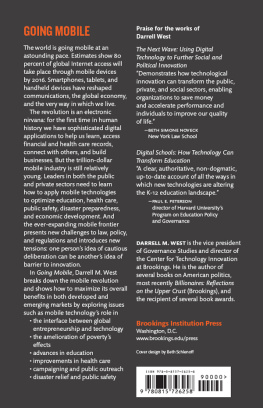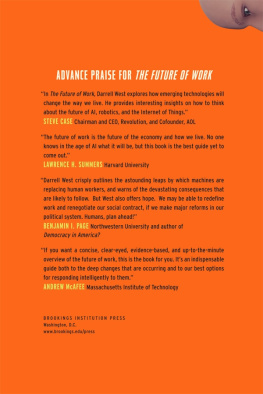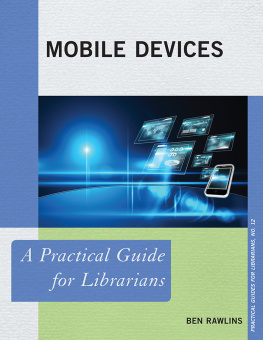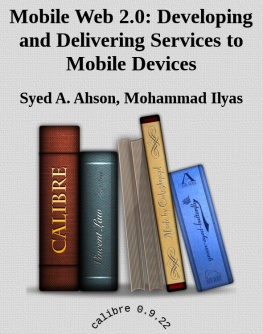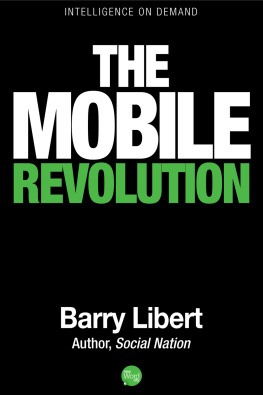I AM INDEBTED TO Hillary Schaub, Elizabeth Valentini, Ashley Gabrielle, Joshua Bleiberg, and Sonia Vora for the valuable research assistance they provided on this book. Elizabeth Valentini helped write portions of on disaster relief and public safety. Several individuals at the Brookings Institution Press deserve a special thank you. Valentina Kalk, who directs the Press, was a tremendous source of good advice about the book. Janet Walker was very helpful in supervising the book production process. None of these individuals is responsible for the interpretations presented in this work.
1 MOBILE TECHNOLOGY
MOBILE TECHNOLOGY IS RESHAPING society, communications, and the global economy. With cell phones, smartphones, and tablets now outnumbering desktop computers, there has been a sea change in the way people access, use, and share information. Powerful mobile devices and sophisticated digital applications enable users to build businesses, access financial and health care records, communicate with public officials, and complete online transactions. More globally, such devices and applications have helped reduce social inequality, increased participation in civic life, and increased education levels, all of which spur national economic development.
This revolution in how consumers and businesses access information, and the far-reaching consequences of such uses, represents a fundamental turning point in human history. For the first time, people are able to connect with one another in a relatively inexpensive and convenient manner around the clock. In both developed and developing countries, the growth in mobile technology has been accompanied by job creation and knowledge transfer, as well as deepened social and economic connections. With the mobile industry generating $1.6 trillion in revenues, it is important to understand how mobile telephony is reshaping our It is this fundamental transformation that I explore in this book.
The Rise of Mobile Technology
Mobile technology is the fastest-growing technology platform in history. According to a GSMA Wireless Intelligence report, the number of mobile subscribers around the globe has risen dramatically, from 2.3 billion in 2008 to 3.5 billion in 2014, and is expected to surpass 3.9 billion by 2017 ( At current growth rates it will take only two and one-half years for the next billion mobile connections to be made.
High growth is especially the case in the developing world as users have skipped the desktop and laptop phases of information technology and shifted directly to handheld devices. People are using cell phones, smartphones, and tablets for communications, commerce, and trade. creating many opportunities for entrepreneurs and businesspeople.
The dramatic switch to mobile technology becomes evident if one examines the trend lines for installed mobile devices and personal computers, which crossed at the end of 2012., the total number of Internet protocol (IP) network-enabled desktops, notebooks, and netbook personal computers in the years before 2012 exceeded that of cellular phones. As more consumers and businesses adopted smartphone technology, however, those devices exceeded the number of personal computers in 2012. Smartphone installation currently is growing at about three times the rate of personal computer installation.
FIGURE 1-1. Growth in Mobile Subscribers, 200817

Source: A. T. Kearney, GSMA: The Mobile Economy (London, 2013).
FIGURE 1-2. Trends in Mobile Devices and Personal Computers, 200914

Source: Ken Hyers, A Peek into the Future of Mobile (Boston, Strategy Analytics, January 2011).
Table 1-1. Percent of Mobile Phone Owners Using Various Services, 2013
| Service | Percent |
| Send or receive text messages | 81 |
| Access the Internet | 60 |
| Send or receive e-mail | 52 |
| Download an app | 50 |
| Get location-based directions | 49 |
| Listen to music | 48 |
| Participate in a video call or chat | 21 |
| Share location | 8 |
Source: Pew Research Center, Internet & American Life Project Survey 2013 (Washington, 2013). The survey was conducted April 17 to May 19, 2013.
Consumers like the convenience of mobile devices. They enjoy being able to access e-mail, conduct e-commerce, and access a wide range of applications on the go. In the United States, a survey by the Pew Research Center found that 90 percent of American adults own a cell phone, 58 percent have a smartphone, and 42 percent own a tablet computer.).
A second important trend is the growth in number of mobile broadband subscribers around the world, which surpassed that of fixed broadband subscribers at the end of 2010 (broadband is expected to increase to 79 percent of all broadband subscriptions by 2015, up from its 2010 level of 37 percent.
FIGURE 1-3. Trends in Mobile and Fixed Broadband, 201015

Source: A. T. Kearney, GSMA: The Mobile Economy (London, 2013).
Not surprisingly, in light of its long-term potential, a number of countries have identified broadband and wireless technology as crucial infrastructure needs for national development. Broadband is viewed as a way to stimulate economic development, enhance social connections, and promote civic engagement. National leaders understand that broadband technology is a cross-cutting technology that speeds innovation in such areas as health care, education, energy, and transportation. When combined with organizational changes, digital technology can generate powerful new efficiencies and economies of scale. Moreover, the creation of new digital platforms across a variety of domains spurs utilization and innovation and brings additional people, businesses, and services into the digital revolution. To cite only two examples, both entrepreneurs and underserved populations stand to benefit from a greater use of mobile technology.
Entrepreneurs play a major role in the economy of many countries. They launch companies, build businesses, and provide jobs. As the world moves toward a global digital economy, entrepreneurs increasingly rely on mobile technology to develop their businesses, reach markets, and pay vendors. This helps them stay in close contact with individuals and entities upstream and downstream of the business and build relationships.
Mobile technology also offers important advantages for those in underserved rural communities, where limited access to broadband and other telecommunication services makes it more difficult to participate, socially and economically, in the modern world. Mobile devices offer a way to gain Internet access even in places that are geographically remote. In larger purview, because of their relatively low cost and ubiquitous connections, mobile devices help overcome digital disparities. There are well-established inequities based on race and ethnicity, as well as certain geographic distinctions, in socioeconomic well-being. In many countries, minorities have lower levels of educational achievement and lower incomes than non-minorities. Yet mobile devices have been able to narrow the gap in technology utilization. A December 2013 report by the Pew Research Center pegged smartphone ownership in the United States at 61 percent among Hispanics and 59 percent among African Americans, both rates slightly higher than among whites (53 percent). Mobile technology helps minorities start businesses, access mobile-based health care applications, engage in mobile-based learning, and otherwise tap into the benefits of the technology revolution.

